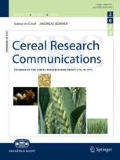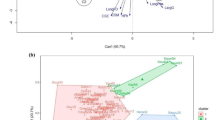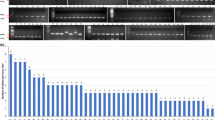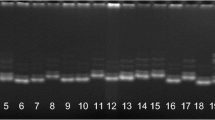Abstract
It is essential to elucidate genetic diversity and relationships among related varieties of origin and landraces for improving the breeding process. Since rice breeding has improved agronomic traits such as yield and eating quality during green revolution, modern rice varieties are originated from narrow genetic resource and closely related. To resolve the population structure and genetic diversity in bold type rice varieties of southern India, we used a total of 81 rice genotypes by 100 simple sequence repeat markers composed of 36 improved varieties and 45 landraces, which are representative and important for bold type grain rice breeding. The landraces exhibit greater gene diversity than improved lines, suggesting that landraces can provide additional genetic diversity for future breeding. Clustering by Ward method was done to establish a relationship among the 81 rice genotypes. All the genotypes were clustered into mainly 5 clusters. Principle component analysis revealed that the first principal component revealed 42.87% variation, while the second component showed 14.01% variation. Among the eight morpho-physiological and plant production traits studied, the relative water content and spikelet fertility percentage contributed towards maximum diversity. Principle co-ordinate analysis evidently differentiated the genotypes to high yielding varieties with common ancestry. Population structure analysis also obviously classified the genotypes into high yielding susceptible and indigenous tolerant groups. These old varieties and landraces present in crop germplasm collections represent a strategic reserve of genetic variation that can be tapped for varieties and understanding of stress response and developing new varieties that are physiologically adapted to highly variable, climate-resilient environments.






Similar content being viewed by others
References
Agrama HA, Eizenga GC (2008) Molecular diversity and genome-wide linkage disequilibrium patterns in a worldwide collection of Oryza sativa and its wild relatives. Euphytica 160(3):339–355
Beena R, Praveenkumar VP, Vighneswaran V, Sindhumol P, Narayankutty MC (2017) Phenotyping for root traits and carbon isotope in rice genotypes of Kerala, Oryza. Int J Rice 54(3):282–289
Beena R, Vighneswaran V, Sindumole P, Narayankutty MC, Voleti SR (2018a) Impact of high temperature stress during reproductive and grain filling stage in rice, Oryza. Int J Rice 55(1):126–133
Beena R, Praveenkumar VP, Vighneswaran V, Narayankutty MC (2018b) Bulked line analysis: a useful tool to identify microsatellite markers linked to drought tolerance in rice. Indian J Plant Physiol 23(1):7–15
Bhattarai U, Subudhi PK (2019) Genetic diversity, population structure, and marker-trait association for drought tolerance in US Rice Germplasm. Plants 8(12):530–539
Bouman BAM, Humphreys E, Tuong TP, Barker R (2007) Rice and water. Adv Agron 92:187–237
Choudhary G, Ranjitkumar N, Surapaneni M, DeborahD A, Vipparla A, Anuradha G, Siddiq EA, Vemireddy LR (2013) Molecular genetic diversity of major indian rice cultivars over decadal periods. PLoS ONE 8(6):e66197
Dellaporta SL, Wood J, Hicks JB (1983) A rapid method for DNA extraction from plant tissue. Plant Mol Biol Rep 1:19–21
Dubey N, Avinasha HA, Jaiwar S, Chickhede L, Mehta AK (2018) Character association and path analysis study in fodder oat (Avena sativa L.). Environ Ecol 33(2A):844–848
Earl DA, Von HBM (2012) STRUCTURE HARVESTER: a website and program for visualizing STRUCTURE output and implementing the Evanno method. Conserv Genet Resources 4(2):359–361
Evanno G, Regnaut S, Goudet J (2005) Detecting the number of clusters of individuals using the software STRUCTURE: a simulation study. Mol Ecol 14(8):2611–2620
FAO [Food and Agriculture Organization] (2018) Food and Agricultural Organization of United Nations, Rome. http://faostat.fao.org. Accessed 8 Aug 2019
Gilavaei MD, Lahigi HS, Rabiei B (2018) Evaluation of drought tolerance in rice cultivars and recombinant inbred lines. Iran J Plant Breed Genet 7(1):1–9
Hazell PBR (2009) The Asian Green revolution. International Food Policy Research Institute, Washington, DC, p 34
Jolliffe IT, Cadima J (2016) Principal component analysis: a review and recent developments. Math Phys Eng Sci 374(2065):343–354
Khush GS (2005) What it will take to Feed 5.0 Billion Rice consumers in 2030. Plant Molecul Biol 59(1):1–6
Manickavelu A, Nadarajan N, Ganesh SK, Gnanamalar RP, Chandra Babu R (2006) Drought tolerance in rice: morphological and molecular genetic consideration. Plant Growth Regul 50(2–3):121–138
Monna L, Kitazawa N, Yoshino R, Suzuki J, Masuda H, Maehara Y, Tanji M, Sato M, Nasu S, Minobe Y (2002) Positional cloning of rice semi-dwarfing gene, sd-1: rice “Green Revolution gene” encodes a mutant enzyme involved in gibberellin synthesis. DNA Res 9:11–17
Nithya N, Beena R, Stephen Roy, Abida PS, Jayalekshmi VG, Viji MM, Manju RV (2020) Genetic variability, heritability, correlation coefficient and path analysis of morpho-physiological and yield related traits of rice under drought stress. Chem Sci Rev Lett 9(33):48–54
Pritchard JK, Stephens M, Rosenberg NA, Donnelly P (2000) Association mapping in structured populations. Am J Human Genet 67(1):170–181
R Core Team (2013) R: a language and environment for statistical computing. R Foundation for Statistical Computing, Vienna
Ravindrababu V, Badri J, Yadav PAS, Bhandana VP, Prinyanka C, Rao LVS, Padmavathi G, Gireesh C, Ram T (2012) Genealogical atlas of high yielding rice varieties released in India. ICAR-IIRR, Rajendranagar, Hyderabad
Rejeth R, Manikanta ChLN, Beena R, Roy S, Manju RV, Viji MM (2020) Water stress mediated root trait dynamics and identification of microsatellite markers associated with root traits in rice (Oryza sativa L.). Physiol Mol Biol Plants 26(6):1225–1236. https://doi.org/10.1007/s12298-020-00809
Reynolds M, Langridge P (2016) Physiological breeding. Curr Opin Plant Biol 31:162–171
Rosamma CA, Elsy CR, Balachndran PV, Francies RM (2003) Pattambi rice varieties. Kerala Agricultural University, Thrissur
Sambrook J, Russell DW (2000) Molecular cloning: a laboratory manual, 3rd edn. Cold Spring Harbor, Cold Spring Harbor Laboratory, pp 345–356
SAS Institute Inc (1990) SAS user’s guide 1990. Version 6. SAS Institute Inc, Cary
Shete S, Tiwari H, Elston RC (2000) On estimating the heterozygosity and polymorphism information content value. Theor Popul Biol 57(3):265–271
Swamy BPM, Shamsudin NAA, Rahman SNA, Mauleon R, Ratnam W, Sta. Cruz MT, Kumar A (2017) Association mapping of yield and yield-related traits under reproductive stage drought stress in rice (Oryza sativa L.). Rice 10(1):33–43
Thomas RH, Victoria LC (1979) The impact of semidwarf varieties on asian rice-breeding programs. Bioscience 29(12):731–735
Vengadessan V, Ramapriya S, Selvarajeswari N (2016) Morpho-molecular diversity analysis of traditional and improved cultivars in rice. Int J Multidiscip Educ Res 1(4):59–65
Verma S, Saxena R, Xalxo MS, Verulkar S (2014) QTL for grain yield under water stress and non-stress conditions over years in rice (Oryza sativa L.). Aust J Crop Sci 8:916–926
Vikram P, Mallikarjuna Swamy BP, Dixit S, Singh R, Singh BP, Miro B, Kohli A, Henry A, Singh NK, Kumar A (2015) Drought susceptibility of modern rice varieties: an effect of linkage of drought tolerance with undesirable traits. Sci Rep 5:14799. https://doi.org/10.1038/srep14799
Wassmann R, Jagadish SVKS, Heuer S, Ismail A, Redona E, Serraj R, Singh RK, Howell G, Pathak H, Sumfleth K (2009) Climate change affecting rice production: the physiological and agronomic basis for possible adaptation strategies. Adv Agron 101:59–121
Zaman NK, Abdullah MY, Othman S, Zaman NK (2018) Growth and physiological performance of aerobic and lowland rice as affected by water stress at selected growth stages. Rice Sci 25(2):82–93
Acknowledgments
The authors thank Dean, College of Agriculture, Vellayani and Associate Director of Research, Regional Agricultural Research Station, Pattambi for extending full support in providing facilities for the research work.
Author information
Authors and Affiliations
Contributions
RB helped in conceptualization. NN, RB and JS contributed to data curation. JS helped in formal analysis. RB contributed to funding acquisition. RB and NN were involved in investigation. RB, JS, PSA, RS, MMV, VGJ and RVM was involved in methodology. SKP helped in project administration. RB, PSA, RS, MMV, VGJ and RVM contributed to resources. JS contributed to software. RB, PSA, RS, MMV, VGJ and RVM helped in supervision.
Corresponding author
Ethics declarations
Conflict of interest
All authors don’t have any conflict of interest regarding this article.
Additional information
Communicated by R. Chibbar.
Rights and permissions
About this article
Cite this article
Nithya, N., Beena, R., Abida, P.S. et al. Genetic diversity and population structure analysis of bold type rice collection from Southern India. CEREAL RESEARCH COMMUNICATIONS 49, 311–328 (2021). https://doi.org/10.1007/s42976-020-00099-w
Received:
Accepted:
Published:
Issue Date:
DOI: https://doi.org/10.1007/s42976-020-00099-w




